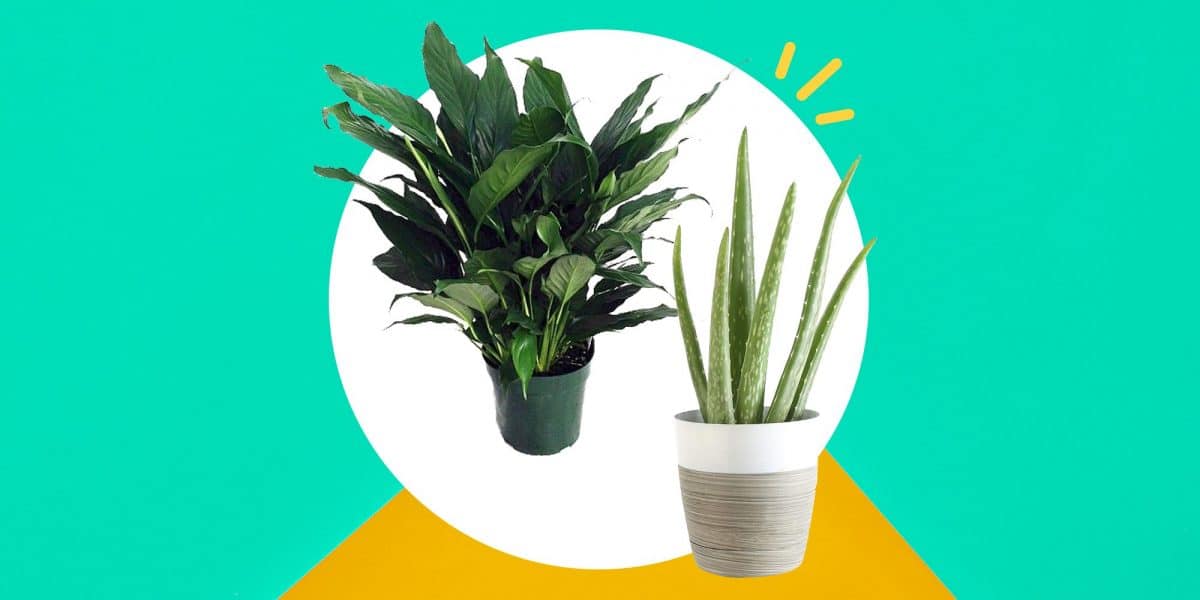Looking for an indoor plant with more to offer than just visual appeal? These seven plants are not only great-looking but healthy for your home, too!
Houseplants have made a major resurgence as a home décor trend over the past few years. But as wonderful as indoor plants can be, they aren’t just a fleeting trend among millennials or people who love to decorate with a vintage, farmhouse vibe.
Houseplants have lots of health benefits, too.
From purifying the air in your home to reducing stress, here are seven of the best houseplants with health benefits to improve the look and feel of your home.
1. Aloe Vera
Aloe vera is one of the most versatile houseplants you can buy. It only takes a second to crack open an aloe leaf and rub the gel onto your skin to heal a burn. For this reason, aloe plants are commonly found in household kitchens.
But aloe does more than heal burns. You can also use the gel as a moisturizer for the skin or rub some on your gums to reduce dental plaque. You can even incorporate aloe into a meal as a way to reduce heartburn.
Aloe plants can thrive in bright light, indirect sunlight, or artificial light. They grow best in rooms between 60 and 75 degrees Fahrenheit, which is the average temperature range for most indoor spaces.
The best part is that they only need water about once every two to three weeks, so you don’t have to worry about hiring a plant sitter if you jet off for a weekend.
2. Lavender Plant
Have you ever wondered why lavender essential oils, lavender bath bombs, and lavender candles are so popular? The scent of lavender comes straight from the natural lavender plant, and there’s one key reason why it shows up in so many health and beauty products:
It helps to reduce stress.
Houseplants, in general, are natural mood boosters, but lavender is especially calming and soothing.
For lavender plants to grow indoors, they need about three to four hours of bright, direct sunlight every day. They also need to live in soil that drains well.
Before watering, let your plant dry out slightly but not completely. When the top inch of soil feels dry to the touch, it’s time to water your plant. In most indoor climates, lavender plants need water approximately every 10 to 14 days.
3. Dracaena
According to the NASA Clean Air Study of 1989, a variety of plants can actually clean the air in your home. One of those is dracaena.
There are many different varieties of the dracaena plant, and many of them have air-purifying abilities. These powerful plants can rid your home of pollutants that you don’t even realize exist, such as formaldehyde and benzene.
Some dracaena plants can grow quite large and sometimes look like small trees. Others are on the smaller side with leaves that grow upright in a spiky formation.
Most dracaena plants require consistent watering to keep the soil moist but not soggy. They tend to thrive best with a bit of food or fertilizer every two weeks or so. The good news is that they don’t need a ton of bright light — most dracaena plants can thrive in front of a window with a sheer curtain.
4. Spider Plant
Formaldehyde gets released into the air from all sorts of household items, including paper bags, napkins, and waxed paper. If you want a great-looking and hardworking houseplant that can absorb formaldehyde from the air in your home, buy a spider plant.
To grow a spider plant indoors, you’ll need to give it a good eight to ten hours of indirect sunlight every day. Too much sun can burn the leaves, while too little light will stunt the plant’s growth.
Spider plants need water about once a week. For the best results, drain the water in the bottom of the pot before adding more water on top.
5. Gerbera Daisies
Do you prefer flowering plants with color as opposed to those that are all green? Consider adding a pot of gerbera daisies to your houseplant collection.
Gerbera daisies are a beautiful air-purifying plant that you can put on display in any room of your home. They can remove formaldehyde, benzene, and trichloroethylene, all things that you can’t see but definitely don’t want to breathe in.
Gerbera daisies can last for two or three years indoors if you care for them in the right way.
To make your gerberas thrive, you’ll need a combo of bright light and temperatures less than 70 degrees. It’s also important not to overwater these plants. Instead, it’s best to water them only when the top inch of soil feels dry.
6. Peace Lilies
Peace lilies are a pretty option if you prefer a plant that produces flowers, but it’s not a great choice for people with a pollen allergy. Peace lilies can reduce a variety of indoor air pollutants, including benzene, xylene, and ammonia.
Peace lilies are relatively easy to grow. They do best in shaded areas, but they can also grow in low light. They also don’t require frequent watering; slightly moist soil is ideal.
7. Rosemary
Most people think of rosemary as an herb, but it is also a great houseplant. And if you like to cook savory meals, it’s a must-have in your kitchen
But rosemary isn’t only for cooking. People have been using this medicinal herb for centuries as a way to improve concentration and memory.
To grow rosemary indoors, you’ll need to place your plant in a window that gets at least six to eight hours of bright light each day. Rosemary plants only need watering about every two weeks, but they do best when their pot is placed in a drainage pan with rocks inside.
Rosemary plants absorb moisture from the air, so as the water drains from the pot into the pan, they’ll be able to absorb that additional moisture.
Conclusion
Some people use plants for purely decorative purposes. Some people love them for their scent and the easy way they help to bring the outdoors into an indoor space. But everyone can reap the health benefits that plants provide.
Houseplants aren’t expensive; you can pick up all sorts of varieties at Lowe’s, Home Depot, and local nurseries for just a few dollars per pot.
And if you don’t have a green thumb, start with an aloe plant. They’re easy to care for, they’re hard to kill, and they are, by far, one of the most versatile plants you can have in your home.
Author Bio
Caitlin Sinclair is the Property Manager at The Eleanor with five years of property management experience and many more in Customer Service. She shares her passion for her community and looks forward to making The Eleanor the place to call home.








